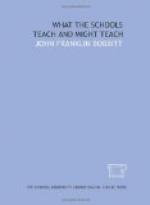It cannot be urged that young people have a life of their own which is to be lived only for youth’s sake and without reference to the adult world about them. As a matter of fact children and youth are a part of the total community of which the mature adults are the natural and responsible leaders. At an early age they begin to perform adult activities, to take on adult points of view, to bear adult responsibilities. Naturally it is done in ways appropriate to their natures. At first it is imitative play, constructive play, etc.—nature’s method of bringing children to observe the serious world about them, and to gird themselves for entering into it. The next stage, if normal opportunities are provided, is playful participation in the activities of their elders. This changes gradually into serious participation as they grow older, becoming at the end of the process responsible adult action. It is not possible to determine the educational materials and processes at any stage of growth without looking at the same time to that entire world of which youth forms a part, and in which the nature and abilities of their elders point the goal of their training.
The social point of view herein expressed is sometimes characterized as being utilitarian. It may be so; but not in any narrow or undesirable sense. It demands that training be as wide as life itself. It looks to human activities of every type: religious activities; civic activities; the duties of one’s calling; one’s family duties; one’s recreations; one’s reading and meditation; and the rest of the things that are done by the complete man or woman.




